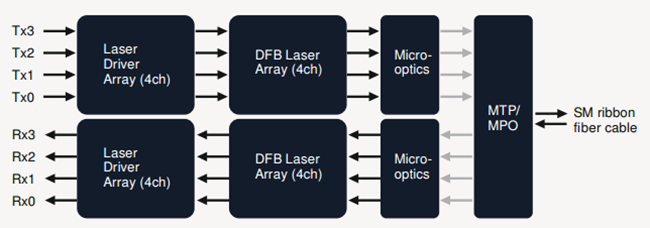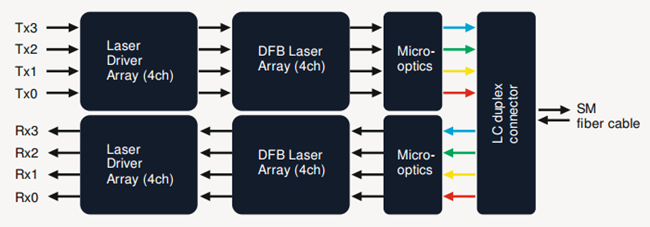Is PSM or CWDM More Cost-effective for 40GBASE-LR4 QSFP+ Optic?
Since 40G Ethernet network becomes much more widely used than ever before to meet the data center needs, there are various 40G optics available in today’s fiber market for different applications. As for short distance application, 40GBASE-SR4 QSFP+ optic has a high performance with the parallel multimode fiber (MMF) link. While for long distance application, 40GBASE-LR4 QSFP+ optic has been put into use that can work with two kinds of links, parallel single-mode fiber (PSM) link and coarse wavelength division multiplexing (CWDM) link. Do you have a good knowledge about the two links? Which one is more cost-effective in 40G long distance transmission? In this paper, it will mainly talk about this topic that may guide you to choose the right link for 40GBASE-LR4 QSFP+ optic.
How does the 40GBASE-LR4 QSFP+ optic work with PSM Link? Generally, it is designed to transmit signals through parallel single-mode fiber (SMF) link that can be also called PSM QSFP+ optic. A PSM QSFP+ optic has four independent channels to transmit and receive 10G signal to achieve a total 40G signal transmission at lengths up to 10 km. MTP/MPO fiber ribbon connector is required in this optic to match with the parallel single-mode fiber link, while the guide pins inside the receptacle is also needed to ensure proper alignment. What should be paid attention to is that the single-mode fiber cable cannot be twisted for the sake of channel to channel alignment.
In its working process, the transmitter module of the optic will accept electrical input signals, while the receiver module has the ability to convert parallel optical input signals via a photo detector array into parallel electrical output signals. Both electrical input and output signals are voltage compatible with common mode logic (CML) levels, supporting a data rates up to 10.3G per channel.

The 40GBASE-LR4 QSFP+ optic with CWDM link is also known as CWDM QSFP+ optic, which takes full advantages of CWDM technology to achieve 40G transmission. Similar to the PSM QSFP+ optic, it also offers four transmitting and receiving channels, and each of the channel is capable of 10G operation for a total 40G data rate with a reach of up to 10 km through single-mode fiber cable.
However, the working process of CWDM QSFP+ optic is much complicated than the previous one, since the duplex LC connector is implemented to accommodate CWDM technology in this optic as shown in the following figure. In its working process, it will firstly use a driven 4-wavelength distributed feedback (DFB) laser array to convert four 10G electrical inputs signals to four CWDM optical signals with different wavelengths, generally 1271, 1291, 1311 and 1331 nm, and then multiplexes these CWDM signals into a single channel as a 40G signal, propagating out of the transmitter module through the SMF. When these CWDM signals come to the receiver module, they will be de-multiplexed into four individual 10G optical signals and transmitted through each individual channel, which will finally be collected by a discrete photo diode, amplified by a transimpedance amplifier (TIA) and output as electric signals.

As we know, 40GBASE-LR4 QSFP+ optic can work with either CWDM link or PSM link, supporting 40G Ethernet network at lengths up to 10 km. Then, which one is more cost-effective? If we only consider the QSFP+ optic cost, it is apparent that the PSM QSFP+ optic is more cost-effective with a single uncooled CW laser and relatively simple array-fiber coupling to an MTP connector.
However, since these two optics are used for long distance transmission, the infrastructure cost for the whole link should be taken into consideration. As mentioned above, the PSM QSFP+ optic uses eight optical single-mode fibers for transmission, but the CWDM one only needs 2 optical single-mode fibers. When the link distance is very long, the fiber cost in PSM QSFP+ optic solution would be much more expensive. Except that, the entire optical fiber infrastructure within a data center has to be changed to accommodate MTP connectors and ribbon cables if the PSM QSFP+ optic is selected to deploy for 40G Ethernet network.
In conclusion, deploying 40G Ethernet network with CWDM QSFP+ optic is a good choice for long distance transmission, which needs much less fibers and enables data center operators to upgrade to 40G connectivity without making any changes.